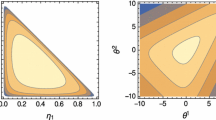Abstract
Some effects of cubic tensors in divergences, which characterize dually flat spaces, are investigated. Focusing on the small area around a specific point, how tangent space approximation is corrected by the cubic tensor at the point, is described. The cubic tensor in divergence is treated as a perturbation, supposing that the coordinates in tangent space are unperturbed solutions. A first order perturbation solution is presented as a main result. On the other hand, the unperturbed solution is yet another coordinate different from the usual affine coordinate. The divergences are shown to be written in a simple form if it is written in terms of the unperturbed solution. Furthermore, a relation which transforms similarities to the divergences is shown. Consequently, the asymmetry in the divergences between the tangent point and the other point is shown to be attributed to the difference between the squared norms of the two kinds of coordinates.

Similar content being viewed by others
Notes
In the following, Einstein notation is also used for Roman letters as \(\langle \theta , \eta \rangle = \theta ^i \eta _i\) and derivatives are also written as \(\theta ^i = \partial \phi / \partial \eta _i = \partial ^i \phi \), \(\eta _i = \partial \psi / \partial \theta ^i = \partial _i \psi \). Furthermore, we identify specific points by Greek letters \(\iota \), \(\kappa \) etc. and use them as indices like \(\theta _\iota \), \(\eta ^\iota \) etc., representing a point \(\iota \) as a vector \(\theta _\iota = (\theta ^1_\iota \cdots \theta ^n_\iota )^\prime \) or a dual vector \(\eta ^\iota = (\eta ^\iota _1 \cdots \eta ^\iota _n)^\prime \). Einstein notation is not applied for these Greek letters.
We assume that the diagonal components \(\hat{d}_{\iota \iota }\) equal to zero.
In the following, we denote the Kronecker delta by \(\delta ^{ij}\) or \(\delta _{ij}\).
References
Amari, S., Nagaoka, H.: Methods of Information Geometry. American Mathematical Society, Providence (2001)
Banerjee, A., Merugu, S., Dhillon, I.S., Ghosh, J.: Clustering with Bregman divergences. J. Mach. Learn. Res. 6, 1705–1749 (2005)
Borg, I., Groenen, P.: Modern Multidimensional Scaling, 2nd edn. Springer, New York (2005)
Bregman, L.M.: The relaxation method of finding the common point of convex sets and its application to the solution of problems in convex programming. USSR Comput. Math. Math. Phys. 7, 200–217 (1967)
Brun, A., Knutsson, H.: Tensor Glyph Warping: Visualizing Metric Tensor Fields using Riemannian Exponential Maps. In: Laidlaw, D.H., Weickert, J. (eds.) Visualization and Processing of Tensor Fields, pp. 139–160. Springer, Berlin (2009)
Kumagai, A.: Multidimensional scaling in dually flat spaces. Jpn. J. Ind. Appl. Math. 32, 51–63 (2015)
Kumagai, A.: Semilocal properties of canonical divergences in dually flat spaces. Jpn. J. Ind. Appl. Math. 33, 417–426 (2016)
Lee, J.A., Verleysen, M.: Nonlinear Dimensionality Reduction. Springer, New York (2010)
MacAdam, D.L.: Visual sensitivities to color differences in daylight. J. Opt. Soc. Am. 32, 247–273 (1942)
Pekalska, E., Paclík, P., Duin, R.P.W.: A generalized kernel approach to dissimilarity-based classification. J. Mach. Learn. Res. 2, 175–211 (2001)
Schölkopf, B.: The kernel trick for distances. In: Neural Information Processing Systems (2000)
Acknowledgements
The author greatly appreciates the valuable comments of the reviewers.
Author information
Authors and Affiliations
Corresponding author
About this article
Cite this article
Kumagai, A. A perturbative picture of cubic tensors in dually flat spaces. Japan J. Indust. Appl. Math. 35, 107–115 (2018). https://doi.org/10.1007/s13160-017-0274-8
Received:
Revised:
Published:
Issue Date:
DOI: https://doi.org/10.1007/s13160-017-0274-8



